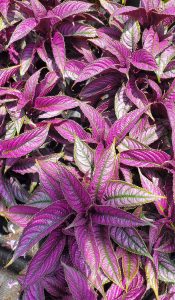
Some plants do not do well in our full-sun landscapes. They are adapted to part-shade to full shade and will otherwise burn up outside of that ideal environment. So, if you have shade, take advantage of this habitat with colorful foliage plants. One such plant you may have seen in practically every garden center is the Persian shield. The pleated foliage of the Persian shield is a colorful combination of florescent purple and green on serrated leaves. Resembling a metallic shield of old, this herbaceous perennial plant can liven up any shady area with color and texture.
Persian shields have been grown since the Victorian era as an ornamental for both inside and outside gardening. As a landscape plant it is hardy in Zone 10 and can grow upwards to three to four feet tall in our favorable conditions. Although initially producing tender growth, the stems can become woody with age and lose their striking color. Worn-out older plants are easily replaced by taking cuttings and starting new vibrant plants at the beginning of each season. In this manner you can almost treat Persian shields as annuals. While the Persian shield can overwinter as a perennial the leaves could suffer freeze damage if we have a cold snap. Not to worry, they are generally hardy enough in our area to resprout from the base in a worst-case freeze scenario.
The six-to-eight-inch leaves of Persian shields are the highlight of this plant. The purple and green leaves with iridescent highlights are enhanced by hot, humid weather. Any flowers that emerge are inconspicuous and not very attractive. In fact, once flowers emerge, the Persian shield is more difficult to propagate from cuttings. Pinching back elongated growth will help form a bushier plant.
Plant Persian shields in partial shade (bright light with no direct sunlight) to full shade, about eighteen inches apart in compost-enriched, well-drained soil for mass-planting. Persian shields also make excellent container culture specimens alone or mixed with other flowering plants. This perennial will appreciate uniform moisture as it is not considered drought tolerant – fortunately, growing in the shade helps retain moisture. Otherwise, the Persian shield is considered a Florida-Friendly Landscaping™ approved plant thanks to its general easy care and contribution to color in the landscape. As mentioned earlier, you can find Persian shields at almost any local garden center or nursery. Their ease of propagation also makes them a classic passalong plant to share with friends and neighbors.
Every plant has its place in the landscape – the Persian shield is no different as a colorful character fond of shady places in our landscapes! For more information on all types of colorful foliage plants to grow in your own yard, or to ask a question, you can also call the Master Gardener Volunteer Helpdesk on Mondays, Wednesdays, and Fridays from 1 to 4 pm at 764-4340 for gardening help and insight into their role as an Extension volunteer. Ralph E. Mitchell is the Director/Horticulture Agent for UF/IFAS Extension – Charlotte County. He can be reached at 941-764-4344 or ralph.mitchell@charlottecountyfl.gov. Connect with us on social media. Like us on Facebook @CharlotteCountyExtension and follow us on Instagram @ifascharco.
Resources:
UF/IFAS Gardening Solutions (2024) Persian Shield. The University of Florida Extension Service, IFAS.
The Florida-Friendly Landscaping Guide to Plant Selection & Landscape Design (2022) The University of Florida Extension Services, IFAS.
Winter, N. (2007) Exotic Persian Shield shines in summer heat. Mississippi State University Extension.
Mahr, S. (2012) Persian Shield, Strobilanthes dyerianus. University of Wisconsin Extension – Madison.
 0
0
